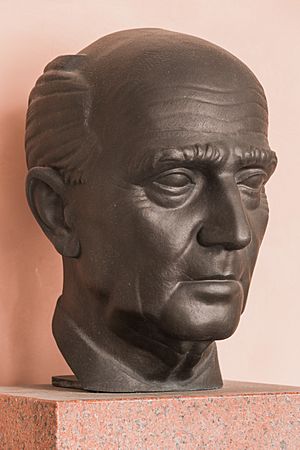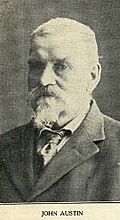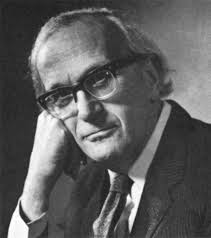Legal positivism facts for kids
Legal positivism is a way of thinking about law. It says that laws are rules made by people, not by some higher power like nature or morality. Important thinkers like Jeremy Bentham and John Austin helped create this idea in the 1700s and 1800s.
A famous legal positivist, H. L. A. Hart, explained that this idea means a few things:
- Laws are commands from humans.
- There is no necessary link between law and what is morally right or wrong.
- Studying what legal words mean is important. This is different from studying law's history or how it affects society.
- A legal system is a closed system. Decisions can be made from existing rules without needing social ideas.
- Moral judgments cannot be proven with facts or evidence.
Historically, legal positivism is different from natural law. Natural law theories believe that laws must be connected to morality. Legal positivists disagree with this idea.
Contents
What Does "Positivism" Mean?
The word positivism comes from the Latin word ponere, which means "to put" or "to place." So, "positive law" means law that has been "put in place" or formally created by people.
How Laws Become Valid
Legal positivists believe that a law is valid if it was created by a recognized legal authority. The law's value or fairness is a separate issue. A law might seem "bad" to some people, but if it was made by the right authority, it is still a law.
The Stanford Encyclopedia of Philosophy explains this simply: "A law being fair or smart is never enough reason to think it's actually the law. And a law being unfair or unwise is never enough reason to doubt it. Legal positivism says law is about what has been put in place (ordered, decided, practiced). It's a social creation."
Legal positivism does not say that people must obey all laws. It also does not say that having clear rules is always good. In fact, laws can be very unfair, and a government might not be legitimate. So, there might be no duty to obey them. Legal positivists believe it's clearer to study these questions separately.
Legal Positivism vs. Legal Realism
Legal positivism is different from legal realism. Both ideas agree that laws are made by humans. However, legal positivists believe that laws often give clear guidance to people and judges. This is especially true in lower courts.
Niklas Luhmann said that positive law is "chosen through decision, and is valid by the power of decision." This means laws can change. But positivists do not say that someone's decision alone makes a law valid. H. L. A. Hart believed that law's validity comes from the common practices of courts.
History of Legal Positivism
Early Ideas
The main idea behind legal positivism comes from Empiricism. Empiricists like Thomas Hobbes, John Locke, and David Hume believed that all knowledge comes from what we can see and experience. They thought that ideas not based on experience were just guesses. This way of thinking helped set the stage for legal positivism.
Later, Logical positivists like Rudolf Carnap and A. J. Ayer added another important idea. They said that to understand reality, we must look closely at how we use words and sentences. A sentence only makes sense if it can be proven by facts or is a simple truth.
How Legal Positivism Works
Legal positivism often uses "conceptual analysis." This means thinkers study legal ideas to understand what they truly mean. This approach assumes that legal ideas are "settled by human thought."
Legal positivism is connected to empiricist ideas. It looks at specific legal systems. This method "uses observation of facts to make general rules." These studies avoid judging what is ethical or moral. As Julius Stone wrote, legal positivism mainly focuses on "analyzing legal terms and how legal statements logically connect."
Laws get their power from their source. A law's validity depends on the rules and customs of a society. It does not depend on its moral value.
Thomas Hobbes and Leviathan
Thomas Hobbes, in his famous book Leviathan, wrote about law based on the idea of a powerful ruler. Hobbes believed that "law depends on the ruler's will." No matter what a law says, if the ruler commands it, then it is law.
Jeremy Bentham
Jeremy Bentham was a very important British legal positivist. In his book An Introduction to the Principles of Morals and Legislation, Bentham said that law is the clear will of a ruler.
Bentham also made a difference between two types of people:
- Expositors – These people explained what the law actually was.
- Censors – These people criticized the law and said what it should be.
Bentham believed that the study of law should focus on what the expositors said, not the censors' criticisms. He famously called natural law "nonsense upon stilts."
John Austin's Command Theory
John Austin followed Bentham's ideas. He wrote The Province of Jurisprudence Determined. Austin believed that law is a command from a ruler. This ruler is obeyed by most people in society. The ruler's power is enforced by punishments. But the ruler is not controlled by any human above them.
Austin's main ideas were:
- Laws are commands from a ruler who is not commanded by anyone else.
- These commands are enforced by punishments.
- A ruler is someone who most people regularly obey.
Austin thought that if people do not follow rules, they face "the sanction of nullity." This means the action they took might be canceled or not recognized.
Hans Kelsen and Germanic Positivism

British legal positivism was based on experience. But Germanic legal positivism, led by Hans Kelsen, was different. It saw law as separate from both facts and morals.
Suri Ratnapala explained Kelsen's ideas:
Facts are things and events in the physical world. They are about what exists. Norms, unlike facts, are about what should be done or not done. Facts are caused by other facts. Norms are created by other norms. For example, the rule that a thief should be punished is a norm. It is still a norm even if the thief is not caught. The norm exists because another norm says so. Not all norms are laws. There are also moral norms. Legal norms can force people to do things; moral norms cannot.
Kelsen believed that every legal system must have a basic, starting rule. He called this the Grundnorm (basic norm). He thought the legal system was like a tree, with all its branches and leaves connected to a common origin.
Kelsen's ideas influenced many scholars around the world, including H. L. A. Hart and Joseph Raz.
H. L. A. Hart
H. L. A. Hart liked Austin's idea of a ruler. But he felt Austin's "command theory" was missing some things. In his book The Concept of Law (1961), Hart developed several important ideas:
- He criticized Austin's idea that law is just a command with a threat of punishment.
- He explained the difference between looking at law from inside (how people who follow the rules see them) and outside (how an observer sees them).
- He separated laws into two types:
- Primary rules: These rules tell people what they can or cannot do (like criminal laws).
- Secondary rules: These rules explain how primary rules are recognized, changed, or used by judges. Hart named three types of secondary rules:
- A rule of recognition: This rule helps anyone in society find out what the main rules are.
- A rule of change: This rule explains how old rules can be changed or new ones created.
- A rule of adjudication: This rule helps society decide when a rule has been broken and what to do about it.
Joseph Raz
Joseph Raz was a student of Hart. He continued to develop Hart's ideas about legal positivism after Hart passed away. Raz also helped edit a new version of Hart's The Concept of Law.
Raz argued that a law's validity can never depend on whether it is moral. However, he later agreed that law might sometimes depend on morality in certain situations.
In Germany, Gustav Radbruch famously rejected legal positivism in 1946. This happened when people who supported the Nazis were being judged. Their actions were legal under Nazi Germany's laws. Radbruch argued that if the difference between a law and justice becomes "unbearable," then that law is "wrong" and should not be followed.
See also
 In Spanish: Iuspositivismo para niños
In Spanish: Iuspositivismo para niños
- Constitution in exile
- Critical legal studies
- Leslie Green
- International legal theory
- Interpretivism (legal)
- Georg Jellinek
- A.V. Dicey
- Judicial activism
- Legal formalism
- Legal naturalism
- Legal process school
- Legal realism
- Legalism (Chinese philosophy)
- Libertarian theories of law
- Living Constitution
- Natural law
- New legal realism
- Philosophy of law
- Positive law
- Rule according to higher law
- Strict constructionism
- Translating "law" to other European languages
- Jurisprudence of concepts
- Jurisprudence of interests
- Jurisprudence of values



